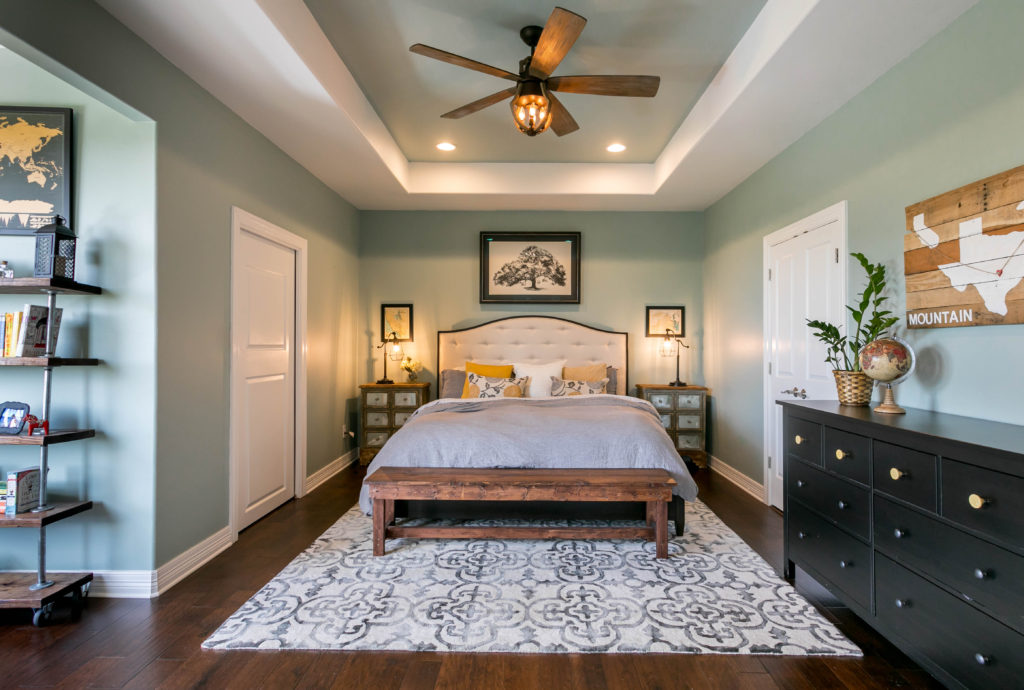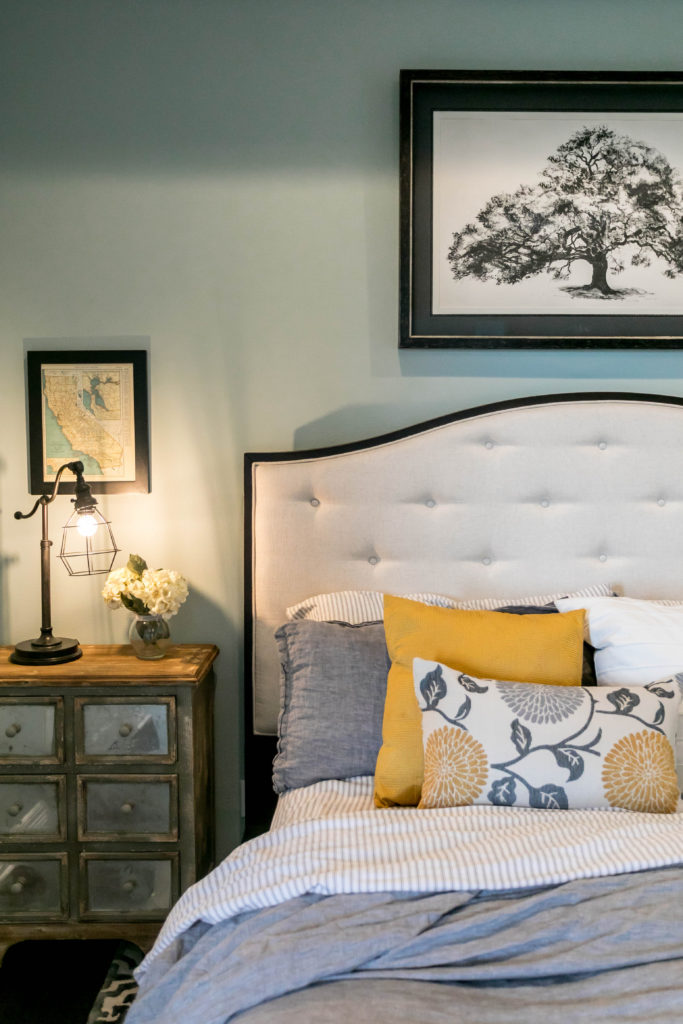Follow these 10 steps to turn your bedroom into a serene sleep oasis
HELPFUL RESOURCES
At Mattress Advisor, you’ll find comprehensive, unbiased reviews on the best mattresses and bedding products and thoroughly researched tips for getting your best sleep.
From clutter reduction to electronics-free sleeping zones, here are 10 of our favorite tips for designing a bedroom that brings you closer to a good night’s sleep.

1. Nix the clutter
If there is one thing, there is certainly no room for in your path towards a better sleep, it’s clutter. Take a word of advice from Marie Kondo, whose KonMari organization method is said to bring about feelings of calmness and serenity.
Create a minimalist aesthetic in your bedroom by:
- Removing stacks of paper
- Reducing overflowing clothing racks and dressers
- Removing dirty clothing from sight
- Eliminating furniture that feels unwieldy or cumbersome
- Paring down on picture frames and other objects that attract dust and make your space feel hectic.
Jonathan Prichard of Mattress Insider explains you should avoid having any type of fitness equipment or office furnishing. Your home office should not be in your bedroom. Computers and work materials should also be kept out of sight, especially during the evening hours. In the bedroom, less really is more.
2. Create a calm aesthetic
A simple and peaceful bedroom is an important component of sleeping well. Start by painting your bedroom a calming hue like white, gray, or a muted shade of blue or green. Then find some neutral colored bedding and simple furniture that fits both the space and your personal preferences.
If you want to add some color without disrupting the room’s calm feel, think about adding houseplants—potted succulents are especially easy to care for. Or buy a rug that contains subtle hints of calming hues. Avoid hanging mirrors in the bedroom as they easily catch and reflect light, which can be distracting. If you want to keep a mirror in your sleeping space, think about tucking it away inside a closet door.
Dmitri Kara of the decorator department at Fantastic Handy Man recommends a piece of ancient Chinese wisdom – avoiding the “death pose.”
“Accustomed to modern interior design, the ‘death pose’ means to position the bed in such a way that it faces a door directly, regardless if entrance or terrace. Having your body, particularly the feet, pointing towards the door supposedly drains your life force and can hurt your well-being.”
Check out Adorable Home for more tips on creating a calming bedroom environment.
3. No TV before bed
One of the simplest moves for better sleep is to stop watching television and movies before bed. In fact, it may be a good idea to take the television—or whatever streaming device you use—out of your room altogether. Not only can televisions and screens disrupt a room’s calming aesthetic, but viewing a few shows before bed can actually disrupt your sleep cycle. If you’re a tv-before-bed devotee, this doesn’t mean you need to cut the cable tomorrow, but you should try limiting your pre-bedtime habit for a while. You’re likely to find yourself sleeping better and feeling way more awake and energized during the day.
4. Leave your cell phone in another room
This suggestion will feel impossible to most these days, but keeping your cell phone out of the bedroom overnight can have a huge positive impact on the amount of rest you get every night. For one, all that time scrolling could actually be spent, well, sleeping. And though you may not realize it, your phone emits a subtle glow of blue light that inhibits the body’s release of melatonin (this is the hormone your body uses to regulate sleep). Staring at the screen for hours before bed means you won’t probably won’t realize how tired you are, ultimately staying up longer and sleeping less.
First, you’ll need to purchase a simple alarm clock so you can ditch the “my cell phone is my alarm” excuse. Then leave your phone somewhere outside of the bedroom at least thirty minutes before bedtime. You can use this reclaimed time to read, journal, or do anything else that feels relaxing and sets you up for a good night of sleep.
If you’re not yet ready to leap into the land of the phone-free bedroom, you can start with baby steps. Flip your phone on “Do Not Disturb” mode and leave it somewhere in your room that’s not accessible from bed. Once you’re comfortable here, you can try removing the phone from your room overnight for good.
5. Style the perfect bedside table
For the best sleep, you’ll want to keep your bedside table minimal, while still curating some important items that will help you sleep well. Here’s what we recommend:

- Lavender, Neroli, or other essential oils that facilitate calmness and rest
- An alarm clock (that doesn’t emit bright light)
- A journal and pen for jotting down thoughts before bed or during the night if you find your mind racing
- A sleep mask, ear plugs, or a white noise machine if you are sensitive to light and noise
6. Find a mattress that works
Just right—that’s how you want your mattress. Any other way and you’ll spend far too much time tossing and turning rather than actually resting. Finding a good mattress depends on a number of factors and may feel overwhelming, but once you know what to look for the process doesn’t need to be a chore. Check out this piece where we guide you through the process of finding a mattress that’s perfect for you. With advice on everything from material, support, and firmness to cost, durability, and where to purchase from, we’ll lead you to a mattress that works.
7. Get your lighting right
Light has a big impact on your circadian rhythm. In dark environments, the eyes let your brain know it’s time to start feeling tired, upon which your brain will release melatonin—the hormone that helps your body move towards rest. For this reason, you’ll want to sleep in complete darkness when possible. This means counteracting distracting sources of bright light that keep you up at night. Try hanging curtains or blinds that keep light out, or wearing a sleep mask. Though keep in mind that both of these techniques may also block out the morning sunlight that makes rising just a tad bit easier.
If you have any electronics in the room that emit distracting light, you’ll want to unplug or cover them, as these can stimulate your nervous system. If you’re having trouble winding down in the evenings, try dimming the lights about an hour before bed to let your body know it’s time to start moving toward rest.
8. Maintain a temperature that works for you
Like light, temperature plays a big role in your ability to fall and stay asleep. If your room is too warm or too cold you probably won’t experience an ideal rest. The National Sleep Foundation recommends an ideal sleeping temperature of between 60 and 67 degrees Fahrenheit, but this will vary from person to person. A few techniques for keeping your room comfortable include installing a programmable thermostat, using ceiling or portable fans, opening the windows to let air circulate, and keeping extra blankets handy if you tend to get cold.
9. Minimize noise
Distracting noises both inside and outside the home are some of the most common sleep disruptors out there. A fan can provide soothing background noise that blocks out distractions, as can a white noise machine. White noise apps can also be a good option for those who sleep with their phone or tablet in the room. If you do keep electronics in the room, it’s important to silence notifications during your sleeping hours to avoid waking up every time someone sends you a message or likes an Instagram photo.
10. Reduce allergens
If you’re sneezing, coughing, or sniffling all night, you won’t be sleeping well. To reduce allergens in the bedroom, vacuum often, wash your sheets and pillows at least once each week, wipe up dust, and open the windows from time to time to let in fresh air. If you have specific allergies, you’ll want to consider buying allergen-free bedding and hypoallergenic mattress and pillow covers.